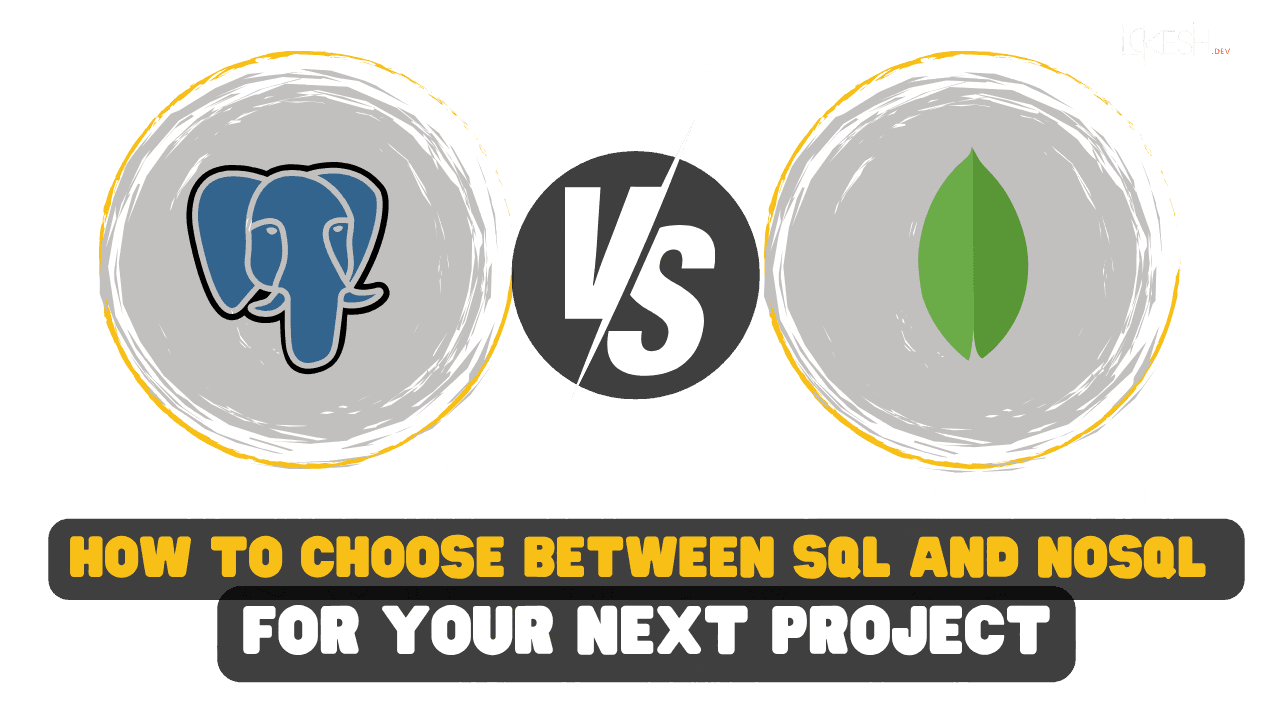October, 08 2025
How to Choose Between SQL and NoSQL for Your Next Project

By ~ Lokesh Raikwar
Introduction: SQL vs NoSQL in 2025
When starting a new web application or software project, one of the most critical choices a full-stack developer faces is selecting the right database. The debate of SQL vs NoSQL is not new, but in 2025 it’s more relevant than ever. SQL databases (also known as relational databases) like PostgreSQL and MySQL have been industry standards for decades, offering structured schemas, strong consistency, and reliability. NoSQL databases such as MongoDB, Cassandra, and Couchbase emerged to handle flexibility, scalability, and unstructured data. Choosing between them depends on factors like the nature of your data, scalability requirements, speed of development, and the type of application you are building. This blog will break down the differences, strengths, and weaknesses of both SQL and NoSQL, giving you a practical framework for making the right decision for your next project.
What is SQL? The Strengths of Relational Databases
SQL (Structured Query Language) databases are relational systems where data is organized in rows and tables with predefined schemas. Popular SQL databases include PostgreSQL, MySQL, MariaDB, and Microsoft SQL Server. The biggest advantage of SQL is consistency and reliability. Transactions in SQL follow the ACID model (Atomicity, Consistency, Isolation, Durability), which ensures that data is accurate and predictable even under heavy usage. This makes SQL the go-to option for applications where accuracy is mission-critical, such as financial software, banking systems, ERP platforms, and healthcare applications. SQL also has decades of community support, robust tools, and well-documented design patterns like normalization. From an SEO and performance perspective, SQL databases handle complex queries efficiently, allowing developers to create dashboards, analytics, and reporting systems with ease. However, SQL databases are less flexible when the data structure changes often, and scaling horizontally across multiple servers can be more complex compared to NoSQL solutions.
What is NoSQL? The Flexibility of Document and Key-Value Stores
NoSQL databases break away from the rigid schemas of SQL. They store data in more flexible formats such as key-value pairs, documents (JSON-like structures), wide-column stores, or graphs. MongoDB is the most popular NoSQL database and is widely used by startups and large-scale systems that prioritize flexibility and scalability. NoSQL excels when working with unstructured or semi-structured data, like user-generated content, social media feeds, IoT sensor data, and real-time analytics. NoSQL systems are designed with horizontal scalability in mind, allowing developers to handle millions of read/write operations by distributing workloads across clusters. This makes them ideal for modern full-stack projects where traffic spikes are unpredictable, such as e-commerce platforms or gaming applications. From a developer productivity perspective, NoSQL databases allow rapid prototyping without worrying about schema migrations. The downside, however, is that they often sacrifice strict consistency in favor of availability and scalability (following the CAP theorem). For applications where data accuracy matters less than speed and flexibility, NoSQL is the clear winner.
When to Use SQL for Your Project
Choosing SQL makes sense when your project requires well-structured data, strict consistency, and complex queries. For example, if you are building a fintech application that handles payments or an e-commerce system that needs accurate inventory tracking, SQL databases like PostgreSQL or MySQL are the better choice. SQL also works well for analytics-heavy systems because its query language can handle joins, aggregations, and relationships between multiple tables efficiently. Another reason to choose SQL is long-term data integrity. If your project must comply with strict regulations (finance, healthcare, government), SQL ensures that your database maintains ACID compliance and meets compliance requirements. In addition, SQL’s mature ecosystem includes ORM (Object Relational Mapping) tools like Prisma, Sequelize, or SQLAlchemy, which make integration with backend frameworks straightforward. In short, SQL is the safer choice when your project’s success depends on accuracy, integrity, and well-defined structure.
Hybrid Approaches: SQL + NoSQL Together
Many modern applications in 2025 don’t strictly choose between SQL and NoSQL — they use both. A hybrid approach leverages the strengths of each system. For example, you might use PostgreSQL to handle structured data like user profiles, transactions, or reporting, while using MongoDB or Redis to handle fast-changing or unstructured data like chat messages, caching, or activity logs. This combination allows full-stack developers to balance consistency with scalability. Cloud providers like AWS, Azure, and Google Cloud make this easier by offering managed SQL and NoSQL databases that integrate seamlessly. Hybrid databases such as FaunaDB and Google’s Firestore also blur the line, offering features of both SQL and NoSQL. The key to success in a hybrid strategy is to clearly define what kind of data belongs where. Structured, mission-critical data goes to SQL, while flexible, rapidly evolving data goes to NoSQL. This trend is growing as businesses seek more agility without sacrificing reliability.
Conclusion: Making the Right Choice
The SQL vs NoSQL debate is not about which database is superior — it’s about which database fits your project requirements best. If you need strong consistency, strict structure, and reliability for financial transactions or regulated industries, SQL is the right choice. If you need flexibility, speed, and scalability for modern, fast-changing applications, NoSQL is the way to go. Many successful full-stack developers in 2025 adopt a pragmatic approach by learning both and applying them where they fit best. From an SEO perspective, fast and scalable databases directly impact page speed, user experience, and retention, which in turn influence search engine rankings. The best way forward is not to commit blindly to one but to evaluate your project’s data type, scalability needs, and long-term goals. By doing so, you’ll not only choose the right database but also future-proof your application for growth and innovation.
Get in touch
We answer quickly. Subscribe for updates or reach out directly.
Let's stay in touch
Based in
![]() Delhi, India
Delhi, India
